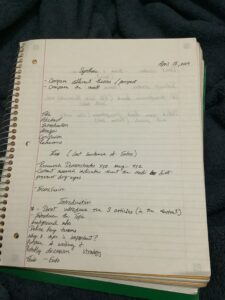Nicole Banegas, Qirat Shahid, Yuliana Blanco
Proposal
Research Question:
- How does food intake on campus affect CCNY students’ energy levels?
- The connection between the two variables is seeing if people eat campus food or outside locations affects their ability to go to class or study.
Two Variables:
Independent Variable: Their food intake
Dependent Variable: The energy levels of CCNY students
Hypothesis:
If we compare food intake and energy levels in students at CCNY, those who have healthier food habits and take time out of their day to eat, will have higher energy levels and be a more productive student, compared to those who don’t eat or rely on unhealthy snacks.
Study Design:
- Survey Questions (All multiple choice questions)
- We’ll measure the energy by ranking the motivation they have to go to class, their concentration, and the motivation to study—overall tiredness at the end of the day. We’ll take into account if people also work.
- Questions would be about their major, year of study, whether they work, age and gender, how many classes they take, food habits, the time they eat food, do they eat breakfast, and their motivation to attend class.
- We will share this survey on Blackboard with our English 21003 class and any friends we have who attend CCNY (which is where we share the QR code or link),.
Purpose:
Our purpose is to collect data that tells when people eat their food. If food intake before class increases energy levels then students/ staff that take food intake after the class will have less energy and feel tired. What effect does a particular food have on a person? Do people still feel hungry after eating? Our purpose is to see how junk and sweet food affect the human body, energy level, level of participation in class, health, benefits, and cons. It is important to learn about our eating intake and habits. So, our bodies can work properly, lead successful lives, and be healthy. This will also help me succeed in college.
Work distribution: Everybody contributed to the research question. Nicole did two Variables. Hypothesis and Purpose were done by Qirat. Yuliana did the study design and survey.
For the lab report, everybody’s role will be as follows:
Nicole: Methods
Qirat: Discussion/Conclusions
Yuliana: Introduction
Everyone: Results, Abstract and graphs
Effect of Eating Habits on Students Energy Levels
Abstract:
College life can cause huge imbalances in an incoming student’s life. Maintaining good food habits is one part of life students struggle with. Financially and academically, students face disparities that can affect their consumption of food and can accuse under or overeating. This study determines whether developing bad eating patterns can affect a student’s academic life and the level of motivation with the ability to study or participate in scheduled classes. In conclusion, With the comparison of food intake and energy levels in students at CCNY, it is expected that those who have healthier food practices and take time out of their day to eat, will have higher energy levels and be a more effective student, compared to those who don’t eat or simply rely on unhealthy snacks. The data collected through the survey supports the possible expected outcome.
Introduction:
Transitioning into college life can heavily affect a student’s food and study habits. The workload and independent study increase the stress levels of students and challenge their ability to create an equilibrium and manageable lifestyle. The heightened stress levels can affect an adolescent’s and young adult’s physical and mental health. In a previous study published by The National Library of Medicine by Tok Chen Yun, Siti Rohaiza Ahmad, and David Koh Soo Quee, titled “Dietary Habits and Lifestyle Practices among University Students in Universiti Brunei Darussalam” speaks on how transitioning to college life can affect food habits and cause a change in how students eat. They had a large sample group and collected their data based on the students’ meal time, if they snacked, and overall eating patterns (Yun et al., 2018). The study highlights how young adults are more likely to develop diabetes due to unstable eating habits and may cause overweight. Our research study focuses on the relationship between the eating habits of college students at the City College of New York and their motivation throughout the day. We conducted a survey as our main source of data, containing questions based on the student’s ability to study and attend classes. We hypothesized if we compare food intake and energy levels in students at CCNY, those who have healthier food habits and take time out of their day to eat, will have higher energy levels and be a more productive student, compared to those who don’t eat or rely on unhealthy snacks.
Methods:
Participants:
The participants were college students aged 18 to 25 years, who are enrolled in the City College of New York (CCNY) located in New York, New York. These students were from different disciplines, though most belonged to the Division of Science. They participated via an online college student discussion board where they were provided a link to a survey and were given multiple-choice questions to answer regarding their food habits and energy levels. The study was open to enrolled students of any age and gender to produce a variety of responses with a total of 32 students having participated in the survey.
Study Design:
The study was conducted through a survey in English over the course of a day on March 19, 2024, at the university. The survey was open to all disciplines within CCNY which included:
- Humanities and the Arts
- The Division of Sciences
- The Social Sciences
- Engineering
- Architecture
- Biomed (Sophie Davis)
- Undecided
Data was collected from all the students who submitted the survey in which all responses were anonymous. The survey consisted of 11 multiple-choice questions. Besides obtaining demographic information such as their current school year, major, age, and gender, the questions were designed to gauge the students’ eating habits and energy levels. The responses recorded also focused on the nutritional value of the meal along with their habits to see how it impacted the student’s energy levels.
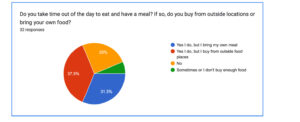
Figure 1: This pie chart shows 25% say no, 37.5% of students say they bring food from home but still buy outside food and 31.5% of students eat food they bring from home. Student #19 whose survey says they were male and a biology major stood out in the data.
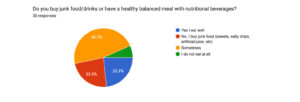
Figure 2. The pie chart demonstrates if the students buy junk food or bring healthy meals. The data shows how 46.7% of students “sometimes” interchange between buying and or bringing packed meals. The other half is varied, but about 8% do not eat at all.
After collecting data on the students’ eating habits, we examined the responses provided on their academic performance and how likely the students were to feel motivated throughout the day. Figure 3 demonstrates the varied percentages of students who felt motivated to study after classes, on a scale of 1-5. The majority have a “neutral” or less likeness to study.
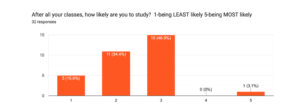
Figure 3: This data shows after all your classes, how likely you are to study? 5 people say 1 out 5, 11 students say 2 out 5, 15 students are likely to study 3 out of 5, 0 students are studying. 4 out of 5 and 1 student say they are likely to study 5/5.
Discussion/conclusion
Our hypothesis is if we compare food intake and energy levels in students at CCNY, those who have healthier food habits and take time out of their day to eat, will have higher energy levels and be a more productive student, compared to those who don’t eat or rely on unhealthy snacks. Our hypothesis was supported by our data even though our questions were not specific. Our data show after all your classes, how likely you are to study? 5 people say 1 out 5, 11 students say 2 out 5, 15 students are likely to study 3 out of 5, 0 students are studying. 4 out of 5 and 1 student said they are likely to study 5/5. This means after taking class the students have full energy to study. Another other question we asked was: Do you take time out of the day to eat and have a meal? If so, do you buy from outside locations or bring your food? 25% say no, 37.5% of students say they bring food from home but still buy outside food and 31.5% of students eat food that they bring from home. Student #19 who identified as male and a biology major stood out in the data. He brings only food from home and is most motivated to study. He ate healthy and he was the only one that had 5/5 energy to study after taking all his classes. This shows us that eating a balanced and healthy meal causes a student to have higher energy. The data we accumulate support our hypothesis.
Our next step in the future is to have a big sample size. Our limitations now were we have a small sample size that we did in our English class that has only 28 students. So by having a big sample size, we will be able to analyze bigger data and get better results. We have taken surveys in NAC and around whole camps. Also, have more very specific questions in the future.
Appendix
The survey was designed to measure how students’ eating habits affect their energy levels. The survey consisted of eleven questions that gauged students’ eating habits and energy levels. It also collected the demographics of the students participating in the survey. The questions included what year they’re in, their major, whether they participate in outside activities, their age, how they identify, their course load, whether they have breakfast, whether they eat outside or bring food to school, the nutritional value of their meal, and how likely they are to study on a scale of 1 (least likely to study) to 5 (most likely to study). Once the data was collected, we were able to measure whether our hypothesis was correct as the data would show a correlation between the students’ food habits, how healthy their diet is, and how it would have impacted their energy levels
References
Yun TC, Ahmad SR, Quee DKS. Dietary habits and lifestyle practices among university students in Universiti Brunei Darussalam. The Malaysian journal of medical sciences : MJMS. 2018 May [accessed 2024 Mar 21]. https://www.ncbi.nlm.nih.gov/pmc/articles/PMC6422551/
Poster
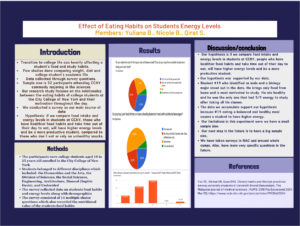
This is a link for Poster pictures
Link: https://www.canva.com/design/DAGAz0kmdqU/92hUOfX2ssssSlZq-sR5Tg/edit?utm_source=shareButton&utm_medium=email&utm_campaign=designshare
This is link for Survey
https://docs.google.com/forms/u/0/d/e/1FAIpQLSf8lbSFRyRb3uu3Yr9APJFsHOYctPf2JI5wBBCYEkHH6dcW6A/viewform?usp=send_form&pli=1
Draft: Proposal
Research Question:
- How does food intake on campus affect CCNY students’ energy levels?
- The connection between the two variables is seeing if people eat campus food or outside locations affects their ability to go to class or study.
Two Variables:
Independent Variable: Their food intake
Dependent Variable: The energy levels of CCNY students
Hypothesis:If we compare food intake and energy levels in students at CCNY, those who have healthier food habits and take time out of their day to eat, will have higher energy levels and be a more productive student, compared to those who don’t eat or rely on unhealthy snacks.
Study Design:
Survey Questions (All multiple choice questions)
We’ll measure the energy by ranking the motivation they have to go to class, their concentration, and the motivation to study—overall tiredness at the end of the day. We’ll take into account if people also work.Questions would be about their major, year of study, whether they work, age and gender, how many classes they take, food habits, the time they eat food, do they eat breakfast, and their motivation to attend class.We will share this survey on Blackboard with our English 21003 class and any friends we have who attend CCNY (which is where we share the QR code or link),.
Purpose:
Our purpose is to collect data that tells when people eat their food. If food intake before class increases energy levels then students/ staff that take food intake after the class will have less energy and feel tired. What effect does a particular food have on a person? Do people still feel hungry after eating? Our purpose is to see how junk and sweet food affect the human body, energy level, level of participation in class, health, benefits, and cons.
Work distribution: Everybody contributed to the research question. Nicole did two Variables. Hypothesis and Purpose were done by Qirat. Yuliana did the study design and survey.
For the lab report, everybody’s role will be as follows:
Nicole: Methods
Qirat: Discussion/Conclusions
Yuliana: Introduction
Everyone: Results, Abstract and graphs
Effect of Eating Habits on Students Energy Levels
Abstract:
College life can cause huge imbalances in an incoming student’s life. Maintaining good food habits is one part of life students struggle with. Financially and academically, students face disparities that can affect their consumption of food and can accuse under or overeating. This study determines whether developing bad eating patterns can affect a student’s academic life and the level of motivation with the ability to study or participate in scheduled classes. In conclusion, With the comparison of food intake and energy levels in students at CCNY, it is expected that those who have healthier food practices and take time out of their day to eat, will have higher energy levels and be a more effective student, compared to those who don’t eat or simply rely on unhealthy snacks. The data collected through the survey supports the possible expected outcome.
Introduction:
Transitioning into college life can heavily affect a student’s food and study habits. The workload and independent study increase the stress levels of students and challenge their ability to create an equilibrium and manageable lifestyle. The heightened stress levels can affect an adolescent’s and young adult’s physical and mental health. In a previous study published by The National Library of Medicine by Tok Chen Yun, Siti Rohaiza Ahmad, and David Koh Soo Quee, titled “Dietary Habits and Lifestyle Practices among University Students in Universiti Brunei Darussalam” speaks on how transitioning to college life can affect food habits and cause a change in how students eat. They had a large sample group and collected their data based on the students’ meal time, if they snacked, and overall eating patterns (Yun et al., 2018). The study highlights how young adults are more likely to develop diabetes due to unstable eating habits and may cause overweight. Our research study focuses on the relationship between the eating habits of college students at the City College of New York and their motivation throughout the day. We conducted a survey as our main source of data, containing questions based on the student’s ability to study and attend classes. We hypothesized if we compare food intake and energy levels in students at CCNY, those who have healthier food habits and take time out of their day to eat, will have higher energy levels and be a more productive student, compared to those who don’t eat or rely on unhealthy snacks.
Methods:
Participants:
The participants were college students aged 18 to 25 years, who are enrolled in the City College of New York (CCNY) located in New York, New York. These students were from different disciplines, though most belonged to the Division of Science. They participated via an online college student discussion board where they were provided a link to a survey and were given multiple-choice questions to answer regarding their food habits and energy levels. The study was open to enrolled students of any age and gender to produce a variety of responses with a total of 32 students having participated in the survey.
Study Design:
The study was conducted through a survey in English over the course of a day on March 19, 2024, at the university. The survey was open to all disciplines within CCNY which included:
- Humanities and the Arts
- The Division of Sciences
- The Social Sciences
- Engineering
- Architecture
- Biomed (Sophie Davis)
- Undecided
Data was collected from all the students who submitted the survey in which all responses were anonymous. The survey consisted of 11 multiple-choice questions. Besides obtaining demographic information such as their current school year, major, age, and gender, the questions were designed to gauge the students’ eating habits and energy levels. The responses recorded also focused on the nutritional value of the meal along with their habits to see how it impacted the student’s energy levels.
After collecting data on the students’ eating habits, we examined the responses provided on their academic performance and how likely the students were to feel motivated throughout the day. Figure 3 demonstrates the varied percentages of students who felt motivated to study after classes, on a scale of 1-5. The majority have a “neutral” or less likeness to study.
Figure 3: This data shows after all your classes, how likely you are to study? 5 people say 1 out 5, 11 students say 2 out 5, 15 students are likely to study 3 out of 5, 0 students are studying. 4 out of 5 and 1 student say they are likely to study 5/5.
Discussion/conclusion
Our hypothesis is if we compare food intake and energy levels in students at CCNY, those who have healthier food habits and take time out of their day to eat, will have higher energy levels and be a more productive student, compared to those who don’t eat or rely on unhealthy snacks. Our hypothesis was supported by our data even though our questions were not specific. Our data show after all your classes, how likely you are to study? 5 people say 1 out 5, 11 students say 2 out 5, 15 students are likely to study 3 out of 5, 0 students are studying. 4 out of 5 and 1 student said they are likely to study 5/5. This means after taking class the students have full energy to study. Another other question we asked was: Do you take time out of the day to eat and have a meal? If so, do you buy from outside locations or bring your food? 25% say no, 37.5% of students say they bring food from home but still buy outside food and 31.5% of students eat food that they bring from home. Student #19 who identified as male and a biology major stood out in the data. He brings only food from home and is most motivated to study. He ate healthy and he was the only one that had 5/5 energy to study after taking all his classes. This shows us that eating a balanced and healthy meal causes a student to have higher energy. The data we accumulate support our hypothesis.
Our next step in the future is to have a big sample size. Our limitations now were we have a small sample size that we did in our English class that has only 28 students. So by having a big sample size, we will be able to analyze bigger data and get better results. We have taken surveys in NAC and around whole camps. Also, have more very specific questions in the future.
References
Yun TC, Ahmad SR, Quee DKS. Dietary habits and lifestyle practices among university students in Universiti Brunei Darussalam. The Malaysian journal of medical sciences : MJMS. 2018 May [accessed 2024 Mar 21]. https://www.ncbi.nlm.nih.gov/pmc/articles/PMC6422551/
Qirat Shahid
May 20,2024
Reflection: Group Projects (Lab Report/Poster)
My biggest strength is to work together in a group and be on track. Another strength is practice using various library resources, online databases, and the Internet to locate sources appropriate to my writing projects. Also, using blackboard to collect data from my survey. My strength was to use mostly logos.I learned that logos are one of the best ways to get reader attention. I have learned to negotiate your own writing goals and audience expectations regarding conventions of genre, medium, and rhetorical situations. For example myGeneral Audience Paper. I have learned to write professionally and scientifically because that is what my audience wants in a literature review. I was able to use scientific, straight forward and professional language and read that lab and understand it. Another strength is practice using various library resources, online databases, and the Internet to locate sources appropriate to my writing essay.
My weakness is enhancing strategies for reading, drafting, revising, editing, and self-assessment because even after revising and editing. I still have grammar mistakes. When I self-assess or revise I would alway see everything is perfect. When it is not. So, for Next time I would go to the writing center for help.
Draft Pictures:
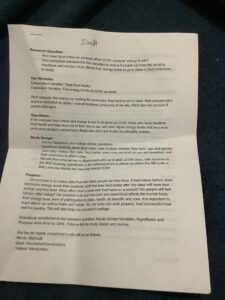
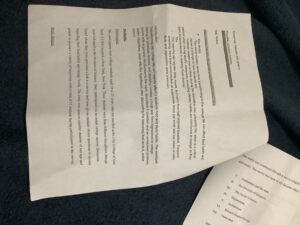
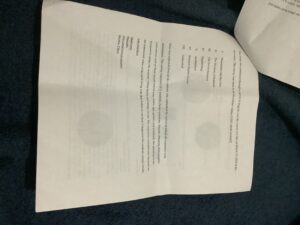
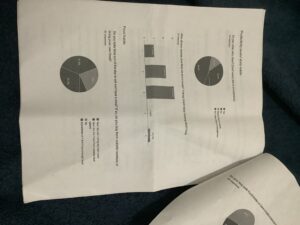
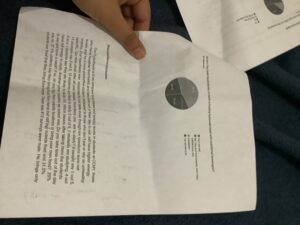
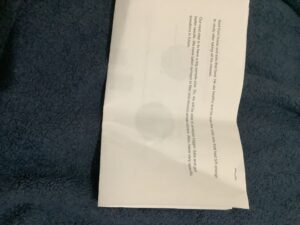
Qirat Shahid
April 16,2024
Topic: Mediterranean Diet Implementation in Dry Eye: Annotated Bibliography
Molina-Leyva I,Molina-Leyva A,Riquelme-Gallego B, Cano-Ibáñez, N, GarcÃa-Molina, L, Bueno-Cavanillas, A. 2020. Effectiveness of mediterranean diet implementation in dry eye parameters: A study of predimed-plus trial. MDPI. [accessed 2024 April 18].https://www.mdpi.com/2072-6643/12/5/1289
Alejandro Molina-Leyva is doctor MD and he works in Hospital Universitario Virgen de las Nieves · He has a PhD in Dermatology. Blanca Riquelme Gallego is a researcher in a research group CTS1068, School of Nursing, Faculty of Health Sciences, is a professor in University of Granada in Spain and PhD in Clinical Medicine and Public Health. Master’s Degree in Human Nutrition and Master’s Degree in Research in Public Health. In the journal Effectiveness of Mediterranean Diet Implementation in Dry Eye Parameters: There was a study of the PREDIMED-PLUS trial. This is about the Mediterranean diet for both genders. In this study there are two groups and both groups, common dry eye tests were conducted at baseline and after six months: the Ocular Surface Disease Index (OSDI), the Dry Eye Scoring System (DESS), tear break-up time (TBUT), the Schirmer’s test, and the Oxford staining grade. There were sixty-seven eyes that were examined. After six months, the dry eye parameters improved in both groups and the differences between groups were favorable for the intensive intervention group. The implementation of a Mediterranean diet pattern was beneficial for dry eye patients, Behavioral support for diet adherence, improved healthy lifestyles and weight loss. I can use this to talk about a Mediterranean diet for both genders to improve dye eyes with the article Effect of aerobic exercise alone or combined with Mediterranean diet on dry eye in obese hypertensive elderly because both of them talk about data they collected from both genders. While on the other hand Effect of a Mediterranean dietary pattern and vitamin D levels on dry eye syndrome online talk about data they collected from mens online.
Galor A, Gardener H, Pouyeh B, Feuer, Florez, H. 2014. Effect of a Mediterranean dietary pattern and vitamin D levels on dry eye syndrome. Cornea. [accessed 2024 April 18],https://www.ncbi.nlm.nih.gov/pmc/articles/PMC3972326/.
Anat Galor is an Ophthalmologist. Her area of expertise is Intraocular Lens, Cataracts, Corneal Diseases and Uveitis. Her research is on dye eyes.All the three articles talk about Mediterranean improved dye eye. This test was on 247 men who underwent DES testing. The patient age was 69 years (range 55 to 95). Adherence to the MeDi was not associated with a beneficial effect on DES. Higher vitamin D levels had a small, but effective effect on DES symptoms. I can use this to show men who are having a Mediterranean diet and get vitamin D really help with improving dye eyes. While the other two journals are about both genders. This is only about mens. I can use this to talk about how some things like vitamin D help improve patient dye eyes. This will be something new because my other two articles do not talk about vitamin D at all. I can use this to talk about different methods to improve dye eyes and connect this with my other articles methods that help these patients.
Ismail A. M. A, El-Azeim A. S. A, Hatem Fawzy Abd Elfatah Abo Saif. 2023. Effect of aerobic exercise alone or combined with Mediterranean diet on dry eye in obese hypertensive elderly – Irish Journal of Medical Science (1971 -). SpringerLink. [accessed 2024 April 18], https://link.springer.com/article/10.1007/s11845-023-03387-6
Ali Mohamed Ali Ismail is a researcher and is connected to Cairo University. In the journal Effect of aerobic exercise alone or combined with Mediterranean diet on dry eye in obese hypertensive elderly. All the three articles talk about Mediterranean improved dye eye. Dye Eye patients who maintained a 6-month energy-expenditure protocol (a 30-min high-intensity aerobic bicycling, 3 times per week) exhibited a lot of improvements in objective/subjective dye eye parameters when this exercise protocol was accompanied by a dietary restriction program, Mediterranean diet. I can use this to talk about high-intensity aerobic bicycling with a Mediterranean diet because my other two articles do not talk about it. I can use this to talk about different methods to improve dye eyes and connect this with my other articles methods that help these patients.
Qirat Shahid
April 16,2024
Draft
Topic: Mediterranean Diet Implementation in Dry Eye : Annotated Bibliography
Molina-Leyva I,Molina-Leyva A,Riquelme-Gallego B Cano-Ibáñez, N, GarcÃa-Molina, L, Bueno-Cavanillas, A. 2020. Effectiveness of mediterranean diet implementation in dry eye parameters: A study of predimed-plus trial. MDPI. (accessed 2024 April 18).https://www.mdpi.com/2072-6643/12/5/1289
Alejandro Molina-Leyva is doctor MD and he works in Hospital Universitario Virgen de las Nieves · He has a PhD in Dermatology. Blanca Riquelme Gallego is a researcher in a research group CTS1068, School of Nursing, Faculty of Health Sciences, is a professor in University of Granada in Spain and PhD in Clinical Medicine and Public Health. Master’s Degree in Human Nutrition and Master’s Degree in Research in Public Health. In the journal Effectiveness of Mediterranean Diet Implementation in Dry Eye Parameters: There was a study of the PREDIMED-PLUS trial. This is about the Mediterranean diet for both genders. In this study there are two groups and both groups, common dry eye tests were conducted at baseline and after six months: the Ocular Surface Disease Index (OSDI), the Dry Eye Scoring System (DESS), tear break-up time (TBUT), the Schirmer’s test, and the Oxford staining grade. There were sixty-seven eyes that were examined. After six months, the dry eye parameters improved in both groups and the differences between groups were favorable for the intensive intervention group. The implementation of a Mediterranean diet pattern was beneficial for dry eye patients, Behavioral support for diet adherence, improved healthy lifestyles and weight loss. I can use this to talk about a Mediterranean diet for both genders to improve dye eyes with the article Effect of aerobic exercise alone or combined with Mediterranean diet on dry eye in obese hypertensive elderly because both of them talk about data they collected from both genders. While on the other hand Effect of a Mediterranean dietary pattern and vitamin D levels on dry eye syndrome online talk about data they collected from mens online.
Galor A, Gardener H, Pouyeh B, Feuer, Florez, H. 2014. Effect of a Mediterranean dietary pattern and vitamin D levels on dry eye syndrome. Cornea. (accessed 2024 April 18),https://www.ncbi.nlm.nih.gov/pmc/articles/PMC3972326/.
Anat Galor is an Ophthalmologist. Her area of expertise is Intraocular Lens, Cataracts, Corneal Diseases and Uveitis. Her research is on dye eyes.All the three articles talk about Mediterranean improved dye eye. This test was on 247 men who underwent DES testing. The patient age was 69 years (range 55 to 95). Adherence to the MeDi was not associated with a beneficial effect on DES. Higher vitamin D levels had a small, but effective effect on DES symptoms. I can use this to show men who are having a Mediterranean diet and get vitamin D really help with improving dye eyes. While the other two journals are about both genders. This is only about mens. I can use this to talk about how some things like vitamin D help improve patient dye eyes. This will be something new because my other two articles do not talk about vitamin D at all.
Ismail A. M. A, El-Azeim A. S. A, Hatem Fawzy Abd Elfatah Abo Saif. 2023. Effect of aerobic exercise alone or combined with Mediterranean diet on dry eye in obese hypertensive elderly – Irish Journal of Medical Science (1971 -). SpringerLink. (accessed 2024 April 18), https://link.springer.com/article/10.1007/s11845-023-03387-6
Ali Mohamed Ali Ismail is a researcher and is connected to Cairo University. In the journal Effect of aerobic exercise alone or combined with Mediterranean diet on dry eye in obese hypertensive elderly. All the three articles talk about Mediterranean improved dye eye. Dye Eye patients who maintained a 6-month energy-expenditure protocol (a 30-min high-intensity aerobic bicycling, 3 times per week) exhibited a lot of improvements in objective/subjective dye eye parameters when this exercise protocol was accompanied by a dietary restriction program, Mediterranean diet. I can use this to talk about high-intensity aerobic bicycling with a Mediterranean diet because my other two articles do not talk about it.
Peer Editing Worksheet
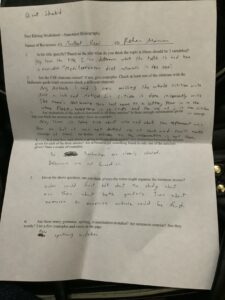
Draft Pictures:
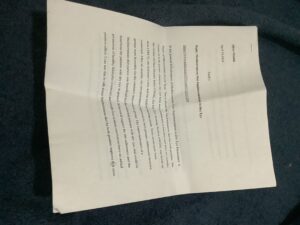
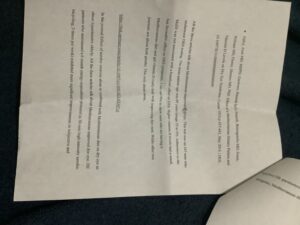
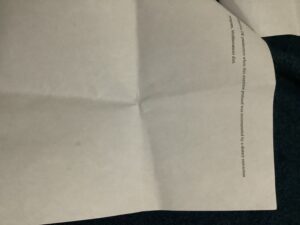
Qirat Shahid
May 20,2024
Reflection: Mediterranean Diet Implementation in Dry Eye: Annotated Bibliography
My strength is that I have mastered the practice using various library resources, online databases, and the Internet to locate sources appropriate to my writing essay. For this part I have to find scholar articles on google scholar. Another strengthen is my source use practices (including evaluating, integrating, quoting, paraphrasing, summarizing, synthesizing, analyzing, and citing sources. I have Given little summary. It was mostly synthetic on each articles and how it will fit in with my literature review.
My weakness is enhancing strategies for reading, drafting, revising, editing, and self-assessment because even after revising and editing. I still have grammar mistakes. When I self-assess or revise I would alway see everything is perfect. When it is not. So, for Next time I would go to the writing center for help. Another weakness is developing and engaging in the collaborative and social aspects of writing processes.
Qirat Shahid
May 14,2023
Mediterranean Diet effects on Dry eyes
Abstract
These articles are Effectiveness of mediterranean diet implementation in dry eye parameters: A study of predimed-plus trial, Effect of a Mediterranean dietary pattern and vitamin D levels on dry eye syndrome and Effect of aerobic exercise alone or combined with Mediterranean diet on dry eye in obese hypertensive elderly – Irish Journal of Medical Science (1971 -). The purpose of all three articles is to evaluate the effect of a Mediterranean diet in dye eyes. To show that the Mediterranean diet really help improve dry eyes.These articles have many similarities and differences but in conclusion they all support that the Mediterranean diet helps improve dye eyes.
Introductions
What are dry eyes? Dry eye that occurs when tears aren’t able to provide adequate moisture.Risk of acquiring this condition increases with age. It’s also seen more commonly among post-menopausal women.The eye may become dry, red, and inflamed. The main symptoms are discomfort and sensitivity to light. There are three articles. These articles are Effectiveness of mediterranean diet implementation in dry eye parameters: A study of predimed-plus trial, Effect of a Mediterranean dietary pattern and vitamin D levels on dry eye syndrome and Effect of aerobic exercise alone or combined with Mediterranean diet on dry eye in obese hypertensive elderly – Irish Journal of Medical Science (1971 -). Current research shows that the Mediterranean Diet affects Dry eyes because something similar is it improves dry eyes, all genders have improved their dry eye specially men and the difference is that they all have something additional to help improve dry eye.
Similarities for all three articles
Common thing that they all have is that a Mediterranean diet improves dry eyes. This occurred because of the non-significant improvement of these objective tests after including 17 middle-aged office workers with definite or anticipated DE in a short-duration 2-month lifestyle-change program (diet modification, energy-expenditure increase through exercise, and positive thinking encouragement) (Molina-Leyva 2020). There was not lots of improvement but there was still improvement.we found that adherence to the MeDi was positively associated with the risk both of having DES (odd ratio (OR) 1.25, 95% confidence interval (CI) 1.06–1.47) p=0.007) and with increasing disease severity ( Galor 2014). The findings of this study are valuable not only for ophthalmologists but also for general practitioners who can give behavioral support and bring additional value to their dietary and healthy lifestyle recommendations: “not only will your cardiovascular health improve, your eye discomfort will too (Ismail 2023). This show all the articles talk about all have is Mediterranean diet improves dry eyes and health. The three articles support that the In the Moline article they test both genders. The male’s age was 55 to 75 years (Molina-Leyva 2020). While the female age was 60 to 75 years. In the article they test 247 men from age 69 years in the range 55 to 95 ( Galor 2014). In the article they specifically did not talk about gender or age but say elderly (Ismail 2023). The similar thing about the age gaven in all three articles is that they are elderly people. There are no young people that are being tested on or middle aged.
Different Methods
All the articles are different in that they all have something additional to help improve dry eye. Supporting the role of exercise in preventing DE, another study showed a significant increase in tear production and a decrease of tear cytokines after involving 43 without-DE healthy participants aged = 23.3 ± 3.6 years in one session of moderate intensity 0.5-h aerobic exercise on a treadmill (Molina-Leyva, 2020). This article only talks about the results to show improvement for dry eyes. higher levels of vitamin D were associated with decreased DES symptoms, with a −1.24 decrease in median DEQ5 score for every 10 unit increase in Vitamin D levels (p=0.01) (Galor, 2014). This shows that it talks about Des but also vitamins D that help increase dry eyes. Dietary n-3 PUFA could modify the anti-inflammatory/pro-inflammatory ratio and decrease pro-inflammatory prostaglandin levels in the lacrimal gland. Supplemented animals showed a decrease in clinical signs of chronic corneal dryness [27,28] (Ismail, 2023). This shows that this article doesn’t talk about DE or vitamins but it talks about PUFA that is helping improve dye eye with Mediterranean diet. Also, articles by Molina and Galor talk about improving dry eye in both male and female gender but Ismail. Even though they are many different, the different tests show that the. The Mediterranean Diet really helps improve dry eyes.
Different age/ gender that are effective by dye eyes
The Mediterranean Diet really helps improve dry eyes. The articles have different ages in their methods and material section. They were tested on both genders. The male’s age was 55 to 75 years (Molina-Leyva 2020). While the female age was 60 to 75 years. In the article they test 247 men from age 69 years in the range 55 to 95 ( Galor 2014). In the article they specifically did not talk about gender or age but say elderly (Ismail 2023). Therefore, This clearly shows that there are different ages being tested on. This means that people from 55 are the people that are really getting dry eyes and are getting tests on. So, there are the age groups that are improving their dry eye with the help of a Mediterranean diet. People from age 55 to 75 are people that really need to pay attention to their diet. From this we can also conclude that in the Moline article there are two genders being tested. While, In Galor’s articles there are only 247 mens being tested on. There is one gender. In the Ismail article they do not specifically list gender listed but it says elderly. Since, they’re more than one biological gender being tested. It demonstrates that a Mediterranean diet helps both women and men.
Conclusion
In conclusion, Current research shows that the Mediterranean Diet affects Dry eyes because something similar is it improves dry eyes, all genders have improved their dry eye specially men and the difference is that they all have something additional to help improve dry eye. Both articles by Molina and Galor talk about improving dry eye in both male and female gender but Ismail. Also, Galor’s article also talks about vitamin D improves dry eye with a Mediterranean diet. But in conclusion all the articles agree that the Mediterranean diet improves dyeing eyes. The similarities that all three articles have is the similar thing about the age gaven in all three articles is that they are elderly people. There are no young people that are being tested on or middle aged. all the articles talk about all have is Mediterranean diet improves dry eyes and health. The difference is there is more than one biological gender being tested. It demonstrates that a Mediterranean diet helps both women and men. There are different ages being tested on. This means that people from 55 are the people that are really getting dry eyes and are getting tests on. Also, there are different things being tested with the Mediterranean Diet.
References
Molina-Leyva I,Molina-Leyva A,Riquelme-Gallego B, Cano-Ibáñez, N, GarcÃa-Molina, L, Bueno-Cavanillas, A. 2020. Effectiveness of mediterranean diet implementation in dry eye parameters: A study of predimed-plus trial. MDPI. [accessed 2024 April 18].https://www.mdpi.com/2072-6643/12/5/1289
Galor A, Gardener H, Pouyeh B, Feuer, Florez, H. 2014. Effect of a Mediterranean dietary pattern and vitamin D levels on dry eye syndrome. Cornea. [accessed 2024 April 18],https://www.ncbi.nlm.nih.gov/pmc/articles/PMC3972326/.
Ismail A. M. A, El-Azeim A. S. A, Hatem Fawzy Abd Elfatah Abo Saif. 2023. Effect of aerobic exercise alone or combined with Mediterranean diet on dry eye in obese hypertensive elderly – Irish Journal of Medical Science (1971 -). SpringerLink. [accessed 2024 April 18], https://link.springer.com/article/10.1007/s11845-023-03387-6
Molina-Leyva, Ignacio, et al. “Effectiveness of Mediterranean Diet Implementation in Dry Eye Parameters: A Study of Predimed-plus Trial.” MDPI, Multidisciplinary Digital Publishing Institute, 1 May 2020, www.mdpi.com/2072-6643/12/5/1289.
- Galor, Anat MD, MSPH; Gardener, Hannah ScD; Pouyeh, Bozorgmehr MD; Feuer, William MS; Florez, Hermes MD, PhD. Effect of a Mediterranean Dietary Pattern and Vitamin D Levels on Dry Eye Syndrome. Cornea 33(5):p 437-441, May 2014. | DOI: 10.1097/ICO.0000000000000089
Ismail, Ali Mohamed Ali, et al. “Effect of Aerobic Exercise Alone or Combined with Mediterranean Diet on Dry Eye in Obese Hypertensive Elderly – Irish Journal of Medical Science (1971 -).” SpringerLink, Springer International Publishing, 9 May 2023, link.springer.com/article/10.1007/s11845-023-03387-6.
Qirat Shahid
May 7,2023
Draft 1:Mediterranean Diet effects on Dry eyes
Abstract
The purpose of all three articles is to evaluate the effect of a Mediterranean diet in dye eye. These articles have man similarities and differences but in conclusion they all support that Mediterranean duet help improve dye eyes.
Introductions
What are dry eyes? Dry eye that occurs when tears aren’t able to provide adequate moisture.Risk of acquiring this condition increases with age. It’s also seen more commonly among post-menopausal women.The eye may become dry, red, and inflamed. The main symptoms are discomfort and sensitivity to light. Current research shows that the Mediterranean Diet affects Dry eyes because something similar is it improves dry eyes, all genders have improved their dry eye specially men and the difference is that they all have something additional to help improve dry eye.
Common thing that they all have is Mediterranean diet improves dry eyes. This occurred because of the non-significant improvement of these objective tests after including 17 middle-aged office workers with definite or anticipated DE in a short-duration 2-month lifestyle-change program (diet modification, energy-expenditure increase through exercise, and positive thinking encouragement) (Molina-Leyva, 2020). There was not lots of improvement but there was still improvement.we found that adherence to the MeDi was positively associated with the risk both of having DES (odd ratio (OR) 1.25, 95% confidence interval (CI) 1.06–1.47) p=0.007) and with increasing disease severity ( Galor, 2014). The findings of this study are valuable not only for ophthalmologists but also for general practitioners who can give behavioral support and bring additional value to their dietary and healthy lifestyle recommendations: “not only will your cardiovascular health improve, your eye discomfort will too (Ismail, 2023). This show all the articles talk about all have is Mediterranean diet improves dry eyes and health.
All the articles have different in that they all have something additional to help improve dry eye. Supporting the role of exercise in preventing DE, another study showed a significant increase in tear production and a decrease of tear cytokines after involving 43 without-DE healthy participants aged = 23.3 ± 3.6 years in one session of moderate intensity 0.5-h aerobic exercise on a treadmill (Molina-Leyva, 2020). This article only talks about the results to show improvement for dry eyes. higher levels of vitamin D were associated with decreased DES symptoms, with a −1.24 decrease in median DEQ5 score for every 10 unit increase in Vitamin D levels (p=0.01) (Galor, 2014). This shows that it talks about Des but also vitamins D that help increase dry eyes. Dietary n-3 PUFA could modify the anti-inflammatory/pro-inflammatory ratio and decrease pro-inflammatory prostaglandin levels in the lacrimal gland. Supplemented animals showed a decrease in clinical signs of chronic corneal dryness [27,28] (Ismail 2023).
This shows that this article doesn’t talk about DE or vitamins but it talks about PUFA that is helping improve dye eye with Mediterranean diet. Also, articles by Molina and Galor talk about improving dry eye in both male and female gender but Ismail.
Conclusion
In conclusion,Current research shows that the Mediterranean Diet affects Dry eyes because something similar is it improves dry eyes, all genders have improved their dry eye specially men and the difference is that they all have something additional to help improve dry eye. Both articles by Molina and Galor talk about improving dry eye in both male and female gender but Ismail. Also, Galor’s article also talks about vitamin D improves dry eye with a Mediterranean diet. But in conclusion all the articles agree that the Mediterranean diet improves dye eyes.
Peer Editing worksheet 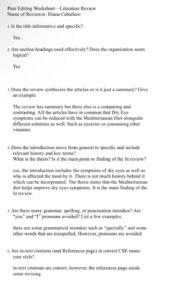
Qirat Shahid
May 20, 2024
Reflection on Literature Review
My strength is that I have mastered the practice using various library resources, online databases, and the Internet to locate sources appropriate to my writing essay. For this part I have to find scholar articles on google scholar. Another strengthen is my source use practices (including evaluating, integrating, quoting, paraphrasing, summarizing, synthesizing, analyzing, and citing sources. I have Given little summary of each article. Also, comparing the three articles. Another strength I have mastered is enhancing strategies for reading, drafting, revising, editing, and self-assessment. For each of the articles I have mastered reading articles for that specific article, drafting, revising, editing, and self-assessment for each of my articles to make it my final draft of Literature Review better. I have used logos because people pay more attention to facts and numbers that are data to prove my point. I have learned to negotiate your own writing goals and audience expectations regarding conventions of genre, medium, and rhetorical situations. For example my literature review. I have learn to write professionally and scientifically because that is what my audience wants in a literature review.
My weakness is enhancing strategies for reading, drafting, revising, editing, and self-assessment because even after revising and editing. I still have grammar mistakes. When I self-assess or revise I would alway see everything is perfect. When it is not. So, for Next time I would go to the writing center for help. Another weakness is developing and engaging in the collaborative and social aspects of writing processes.
Notes:

